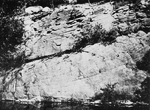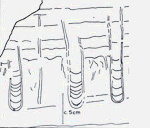ROCK STRUCTURES AND FOSSILS
The Potsdam Sandstone consists of sand-rich, river-transported sediment that interfingers with the sandy sediments of a marine shoreline. Note the lack of shales (mudstone) in the stratigraphic column (Fig. 2). There are places in the basal part of the sandstone, however, where sand gives way to pockets of coarse conglomerate—to boulders and cobbles of gneisses, quartzites and other crystalline rocks. Called talus, the debris accumulated at the base of low hills and ridges that once protruded as islands in the shallow Cambrian sea.
The sandstone displays cross-bedding where the layers are inclined to the horizontal. Cross beds indicate the presence of currents, such as the flow of a river across a delta or the ebb and flow of strong tidal currents. Mounds of sand in shallow water were moved forward, inch by inch, as the sand grains trickled down the frontal incline. Most cross beds are small-scale features (Fig. 9), but some are comparable in size with the cross bedding observed in large desert sand dunes (Fig. 10). G. H. Chadwick, a well-known geologist, proposed (incorrectly) in 1920 that the Potsdam Sandstone was aeolian (wind blown) in origin, sort of a preserved desert landscape. One can measure the compass direction of the inclined layers and infer the general direction of current movement, whether caused by water or wind. In the Thousand Islands area, most of the sandstone cross-bedding was oriented toward the southwest, suggesting that currents in the Cambrian seas had funneled the sand between bedrock hills and ridges that were oriented northeast-southwest.

Figure 9. Small-scale cross bedding, inclined to the left, in tan to rusty Potsdam Sandstone. The layer (enclosed by brackets) lies above a foot-long rock hammer. Elsewhere, the bedding planes are horizontal. Note the broken, rectangular edges of sandstone slabs (center of photo) outlined by bedding planes and vertical joints. Indian River Road west of Oxbow, N.Y.

Figure 10. Very large cross beds on the face of a quarry in Potsdam Sandstone. The size of the cross beds is similar to that of desert sand dunes. The outcrop formed a bluff on the Raquette River below the power house at Hannawa Falls when photographed by J. Reed, 1934, p. 84.
Mudcracks and ripple marks also occur in Potsdam Sandstone. Ripple marks with vertical crests were formed by the gentle, back-and-forth oscillation of water, whereas the inclined crests were produced by waves and tidal currents. The preservation of mudcracks in the rock points to the former presence of tidal flats where shallow water alternated with mudflats.
Beds of quartz sand are ill suited for the preservation of organisms, and fossils are scarce in the Potsdam Sandstone. A few silicified brachiopods and a graptolite locality have been reported, and Late Cambrian trilobites were found outside St. Lawrence and Jefferson counties. Trace fossils, however, are locally abundant. They are sedimentary structures left by organisms, and not the remains of the organism itself; they consist of trails, tracks, burrows or tunnels left at the time of sediment deposition. Trace fossils in the Potsdam Sandstone consist chiefly of vertical burrows that were dug by elongate animals attempting to hide from an enemy (Fig. 11). Such animals are called suspension feeders because they consumed detritus and microorganisms suspended in the sea water. Modern suspension feeders and their burrows are abundant in nearshore, intertidal environments.

Figure 11. Sketch of vertical burrows, a few inches deep, on the face of an outcrop of Potsdam Sandstone. The holes were dug in soft-bottom sediments by suspension feeders. Each hole was filled with crescent-shaped layers of sand and silt before consolidation into solid rock. Note the scale of 5 centimeters (about 2 inches). Reproduced from W. Kirchgasser, 1971, p. B-9.

